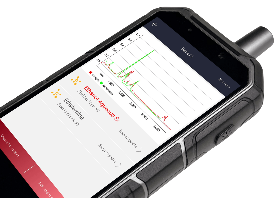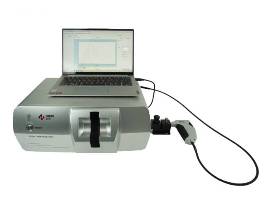Spectroscopy
Advanced spectroscopy instruments including Raman, FTIR, and LIBS for material, chemical, and process analysis across research, pharma, mining, and environmental sectors.

Handheld Raman spectrometers

Lab Raman

Online Raman

Online FT-IR

LIBS
What is Raman Spectroscopy?
Raman Spectroscopy is a non-destructive and non-invasive analytical technique that uses a non-destructive and non-invasive analytical instrument to study vibrational, rotational, and other low-frequency modes in molecules and materials. When monochromatic light interacts with a sample, inelastic scattering occurs, which detects trace levels of compounds by detecting the inelastic scattering of monochromatic light. Raman scattering allows scientists to determine the vibrational modes and molecular structure of samples by shifting the energy of scattered photons.
Overview of Key Spectroscopy Techniques
This summary provides a concise comparison and application overview of handheld, laboratory, and online Raman spectroscopy; FT-IR (Fourier Transform Infrared) and online FT-IR spectroscopy; and LIBS (Laser-Induced Breakdown Spectroscopy).
Raman Spectroscopy
Handheld Raman Spectroscopy
- Compact, portable devices for rapid, on-site, non-destructive analysis.
- Widely used in forensics, pharmaceuticals, law enforcement, and field-based identification of unknown substances, including drugs and explosives.
- Can analyze materials through packaging, reducing contamination risk, and sample handling.
- Surface Enhanced Raman Spectroscopy (SERS) can further enhance sensitivity for trace analysis, such as detecting pesticide residues or drug traces.
Laboratory Raman Spectroscopy
- Offers higher sensitivity, resolution, and advanced analytical capabilities compared to handheld models.
- Used for detailed research in materials science, life sciences, pharmaceutical development, and advanced forensic investigations.
- Enables in-depth structural and compositional analysis of solids, liquids, and even biological samples.
Online Raman Spectroscopy
- Integrated directly into manufacturing or processing lines for real-time monitoring and quality control.
- Enables continuous, automated verification of raw materials, intermediates, and final products, especially in pharmaceuticals and chemical industries.
FT-IR (Fourier Transform Infrared) Spectroscopy
FT-IR Spectroscopy
- Laboratory-based technique for chemical analysis and material identification by measuring infrared absorption spectra.
- A powerful tool for molecular fingerprinting that can be used for forensics, pharmaceuticals, polymers, and environmental sciences.
- Particularly suitable for identifying organic compounds, functional groups, and monitoring chemical reactions.
Online FT-IR Spectroscopy
- Deployed in process environments for real-time monitoring and control.
- Allows continuous analysis of production streams, enabling rapid detection of deviations or contaminants, and supporting process optimization.
LIBS (Laser-Induced Breakdown Spectroscopy)
- The atomic spectroscopy technique uses a focused laser pulse to ablate a small amount of sample, creating a plasma whose emission is analyzed for elemental composition.
- Available in handheld and portable formats for field use, as well as laboratory setups.
- Especially useful for rapid elemental analysis of metals, alloys, soils, and environmental samples, including detection of light elements not easily measured by XRF.
- Increasingly used in recycling, mining, environmental monitoring, and industrial quality control.
Comparison Table
| Technique | Portability | Main Use Cases | Key Advantages | Typical Applications |
|---|---|---|---|---|
|
Handheld Raman |
High |
Field identification, forensics, pharma |
Non-destructive, through packaging |
Law enforcement, QC, customs |
|
Laboratory Raman |
Low |
Research, detailed analysis |
High sensitivity/resolution |
Materials science, R&D |
|
Online Raman |
Medium/High |
Process monitoring, real-time QC |
Automated, continuous analysis |
Pharma, chemicals |
|
FT-IR |
Low |
Lab-based chemical/material ID |
Broad molecular info, functional groups |
Polymers, drugs, forensics |
|
Online FT-IR |
Medium/High |
Process monitoring, real-time QC |
Continuous, non-invasive |
Manufacturing, food, pharma |
|
LIBS |
High |
Elemental analysis, field/lab |
Rapid, light element detection |
Mining, recycling, environment |
Summary
Handheld and online spectroscopic techniques (Raman, FT-IR, LIBS) enable rapid, on-site, and real-time analysis, supporting applications from field forensics to industrial process control.
Laboratory techniques offer greater analytical depth and precision, essential for research and detailed material characterization.
LIBS excels in elemental analysis, especially for light elements and rapid screening.
Raman and FT-IR provide complementary molecular information, with Raman excelling in non-contact analysis and FT-IR in functional group identification.
These technologies are increasingly integrated into portable, robust devices, expanding their utility across industries and environments.
FAQs
How Does a Raman Spectrometer Work?
A Raman spectrometer operates by directing a high-intensity laser at a sample. The basic process involves:
- The laser excites the sample, causing molecular vibrations.
- Most light is scattered at the same wavelength (Rayleigh scatter), but a tiny fraction is scattered at different wavelengths (Raman scatter), corresponding to molecular vibrations.
- The scattered light is collected and filtered to remove the intense Rayleigh component, isolating the weaker Raman signal.
- The spectrometer disperses the remaining light onto a detector, producing a spectrum that displays the intensity of Raman-scattered light as a function of its energy shift relative to the laser.
When a sample is analyzed by spectroscopy, chemical bonds and molecular structures can be identified
What is a Raman Spectrometer Used For?
There are many fields of research where Raman spectrometers are used for non-destructive chemical analysis, including:
- Identifying chemical compounds and materials by their molecular fingerprint
- Determining molecular structure, phase, and crystallinity
- Investigating material properties such as composition, doping, and polymorphism
- Applications in mineralogy, archaeology, food chemistry, pharmaceuticals, forensics, and biological studies
Because Raman spectroscopy requires minimal sample preparation and is non-destructive, it is especially valuable for analyzing delicate or precious samples.
What is the Difference Between Handheld and Laboratory Raman Systems?
Laboratory Raman Spectroscopy
| Feature | Handheld Raman Spectroscopy | Laboratory Raman Spectroscopy |
|---|---|---|
|
Portability |
Compact, portable, battery-operated |
Larger, benchtop, stationary |
|
Use Case |
Field analysis, rapid screening |
Detailed research, complex analysis |
|
Sensitivity/Resolution |
Lower sensitivity and resolution |
Higher sensitivity and resolution |
|
Sample Types |
On-site, in situ measurements |
Wide range, including microanalysis |
|
Flexibility |
Limited customization |
Highly customizable, multi-modal |
Handheld Raman systems are designed for quick, on-the-spot identification of materials in the field, such as forensics, pharmaceuticals, or hazardous materials detection. They prioritize portability and ease of use but generally offer lower sensitivity and resolution than their laboratory counterparts. Laboratory Raman spectrometers, on the other hand, are optimized for detailed research and analysis, providing higher performance, greater flexibility, and advanced features for in-depth studies.
